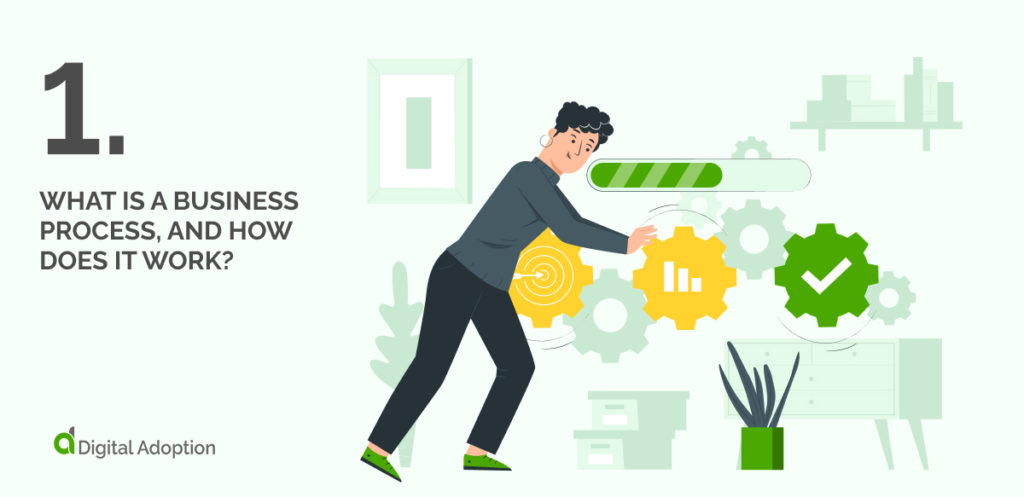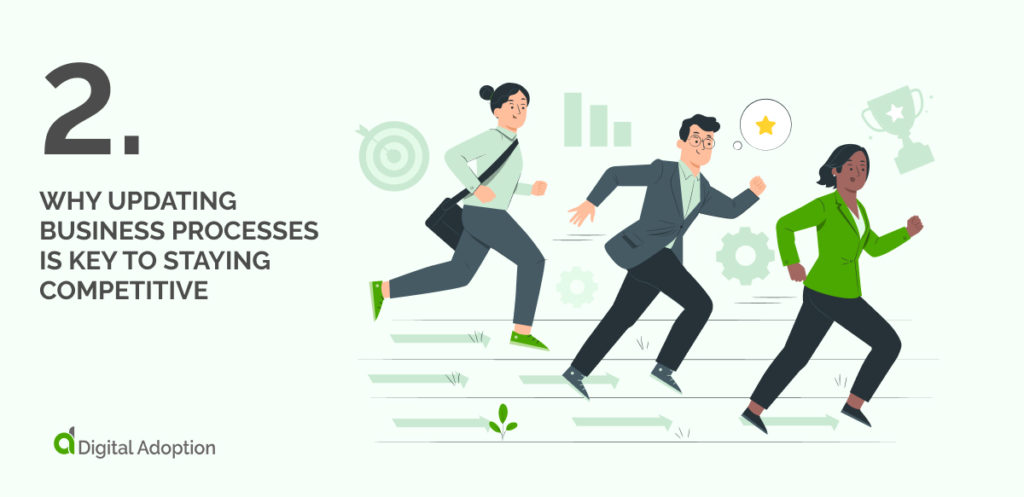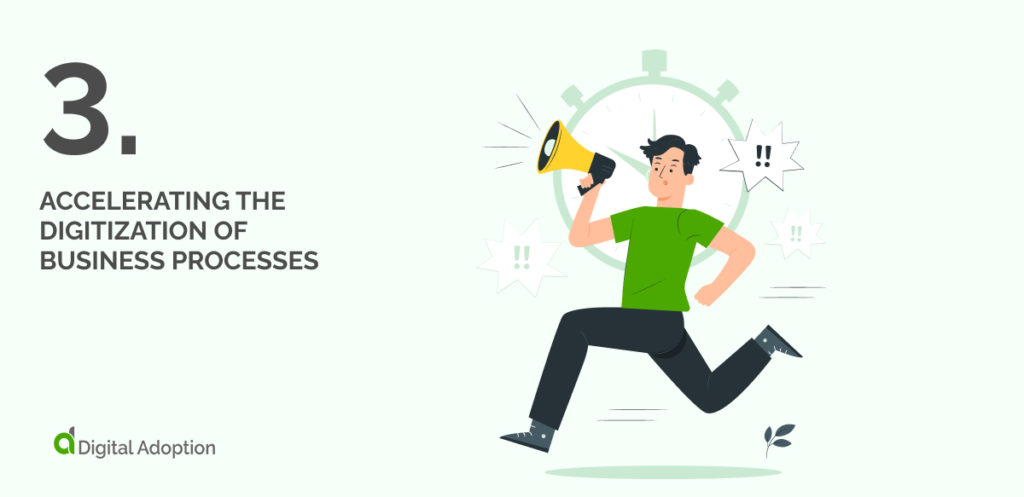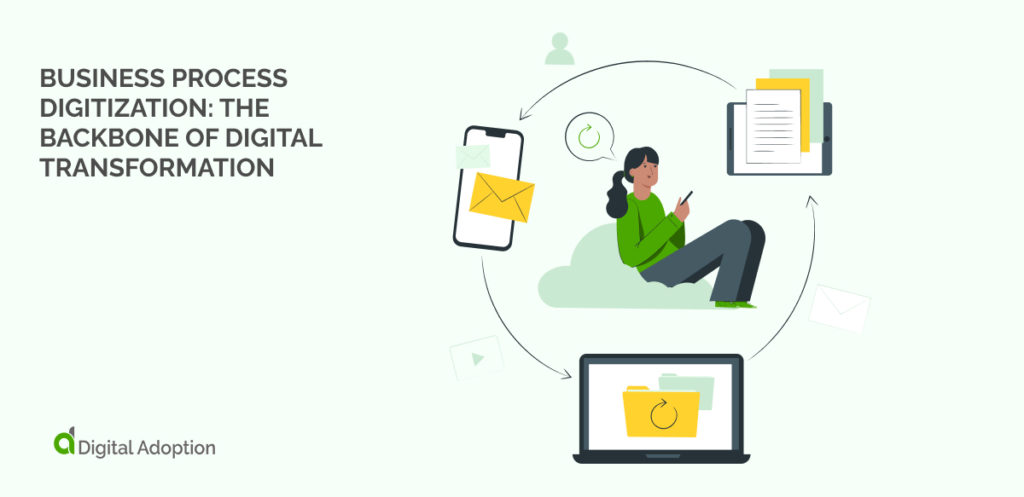As businesses grow, operational processes can become multifaceted and overly complex. This is especially true if a business operates across multiple locations or outsources its needs like customer service or product creation. As such, the demand for digital-driven solutions that simplify these ongoing complexities has led to the widespread digitization of entire business operations.
The rise of digital transformation (DX) and subsequent digital adoption initiatives has driven business growth through the digitization of existing processes. Statista projects global digital transformation spending will reach 1.6 trillion U.S dollars in 2022, eventually rising to 3.4 trillion U.S dollars by 2026.
In the wake of digitization efforts, digital adoption opportunities naturally will follow. This may involve procuring SaaS or PaaS, launching AI-driven task automation, using cloud-based applications, or investing in mobile technologies.
Before going digital, business and IT leaders must consider the organizational motivations for doing so. Existing processes may be inefficient due to a lack of technology, reliance on paper documents, or human error. Business and IT leaders must identify pain points and deploy solutions that fast-track productivity.
- Internal, External, and Existing Business Processes
- Three Key Steps for the Digitization of Existing Business Processes
- 1. What Is A Business Process, and How Does It Work?
- 2. Why Updating Business Processes is Key to Staying Competitive
- 3. Accelerating the Digitization of Business Processes
- How Business Process Digitization Can Transform Your Company
- Business Process Digitization: The Backbone of Digital Transformation
- Enhanced Business Process Management: The Future of Transformation
Internal, External, and Existing Business Processes
Internal business processes are the ones your company uses to complete tasks and goals. They involve financial accounting, employee management, customer service, and product creation. Many of these processes are paper-based and can be time-consuming. This is where digitization comes in handy because it allows you to automate and manage these processes more efficiently.
External business processes are the ones that interact with customers or other businesses. Examples include online ordering, marketing campaigns, and supply chain management. These processes are typically more visible to customers and involve more interactions. Because of this, they need to be streamlined and efficient so that customers have a positive experience. Again, digitization can help you accomplish this by automating tasks and reducing errors.
An existing process can be digitized in several ways. One popular business model is to use software that automates tasks and eliminates paper records. This can be done with accounting software, customer relationship management (CRM) systems, and enterprise resource planning (ERP) platforms. Another way to digitize processes is to use mobile apps or web-based solutions that allow employees to access information and complete tasks from anywhere.
Understanding the different types of organizational processes is key for knowing which areas need prioritizing. Overall, the benefits of digitizing business processes are numerous. The most important benefit is that it can help you save time and money. Other benefits include increased efficiency, improved accuracy, and enhanced customer satisfaction.
Three Key Steps for the Digitization of Existing Business Processes
Digitizing existing business processes can be daunting. But with careful planning and execution, it can be done relatively quickly.
Here are three steps to help you get started:
1. What Is A Business Process, and How Does It Work?

A business process involves a series of tasks that people complete according to a set schedule. The goal is to create products or services for certain customers. Not all consumers are aware of internal business processes, which take place at every level within a company. One way to better understand these processes is by visualizing them as flowcharts. This will show you how activities and tasks fit together in sequence and how data influences the path.
Your company will function more efficiently internally and externally when business processes are carried out effectively. This results in happier customers because they are satisfied with your product or service and a quicker reaction time to changes in your market. Furthermore, departments within the company will be able to work together more fluidly.
Business process management tools can be extremely helpful in managing business processes. They also promote transparency and consistency, which are essential in any organization. A few different types of business process management tools are available on the market. Some are more comprehensive than others. The most important thing is to choose a tool that will work well for your company and your specific needs.
You should always start with a clear objective when developing any business process. This sought-after result or achievement provides value for the customer and drives your decisions from beginning to end. One specific individual should be assigned as the process owner, ensuring everything runs smoothly according to plan.
Business processes can be divided into operational, management, and support. Operational processes are the heart of your company’s success and include creating value streams such as making products or taking customer orders. Management processes include methods used to control things like employee productivity and budgeting. Lastly, supportive processes help manage the core operational methods and encompass tasks such as providing technical support or safety training.
2. Why Updating Business Processes is Key to Staying Competitive

If you need clarification on why digitizing your business processes is integral, you likely have not spoken to any customers recently. Nowadays, customers want a speedy digital experience with a flawless user interface, according to McKinsey’s most recent findings.
Not only do your clients expect answers to their questions quickly, but they also don’t want to be asked the same question multiple times. They may also need help understanding why a bank would need salary slips for proof of income when money is deposited into that bank account every month.
However, more traditional companies may need help improving the customer discovery process, allowing more innovative organizations that take advantage of six sigma business transformation to compete successfully in the market and deliver exceptional digital products and services.
Customers today seek companies that have modernized their business practices and implemented user-friendly interfaces, constant availability, and customized services. They want quick and easy-to-use solutions with no errors or inconsistencies. In other words, they are looking for a superior user experience. This is why it is so important for businesses to digitize their processes to stay competitive in today’s world.
3. Accelerating the Digitization of Business Processes

Simply automating an existing business process will not suffice to meet customer demand. You have to streamline the entire method, which includes reducing the number of steps and paperwork. In addition, automated decision-making steps must be implemented along with regulatory management (learn how technology and data analytics improve operational efficiency).
When developing new data models, it’s essential to be efficient and have good customer insight. You may need to rebuild your system and hire additional employees, such as a user-experience designer or data scientist.
By digitizing information-based business processes, companies can reap impressive Before benefits, such as reducing costs by up to 90 percent and shortening turnaround times for internal managers and external customers. For instance, after incorporating the digitization of business processes, one bank decreased its preliminary approval time for loans from a few days to just one minute.
Not only does automating processes and paperwork improve company performance, but it also helps managers identify potential risks and develop solutions to them. Dashboards and real-time reports allow business managers to spot problems early on and take corrective action before they become serious growth issues.
You need to design the future state you seek for a particular process before you can start digitizing. To do so, focus on your desired goal and work backward instead of dwelling on current system setbacks. Assess each constraint by working backward from the designed future state and addressing it with regulator and customer cooperation to find ways around any challenges.
Furthermore, you must be in charge of the entire customer experience to make an easily navigable system for users. When developing a seamless customer experience, it is helpful to have input from those who will use the product–the customers.
Some companies are investing their time and resources into “start-up-style, cross-functional units that bring together all colleagues—including IT developers—involved in the end-to-end customer experience,” as stated in a McKinsey&Company paper. By doing this research and development, these businesses hope to create products that perfectly suit their consumers’ needs.
A company-wide effort is essential to necessitate excellent lines of communication between colleagues to create a smooth user experience (read more about the importance of cultivating a Culture of Experimentation). Furthermore, businesses are looking to develop in-house capabilities. Staff skilled in technology must be hired and trained promptly to digitize business processes effectively. When deciding which supervisors will take part in this shift, it is crucial that these individuals are carefully chosen and fully trusted.
According to the McKinsey report, digitizing end-to-end business processes one by one can improve performance in only a few months. While moving quickly is not always possible, it benefits IT development. In addition, your company may want to bring in a new organizational unit to manage designing digital processes and bring current employees while raising the volumes handled in this department.
To digitize your business processes, follow these steps and use time management software products. These software products can help you implement innovative, digitized business processes successfully.
How Business Process Digitization Can Transform Your Company
It can be challenging to determine the value and potential impact of digital technologies, processes, and transformation when there is so much discussion. Many terms used in relation to digital business are merely buzzwords with no real meaning. It is important to cut through the hype and understand these terms.
Businesses digitize their processes to take advantage of new technology, update old methods, and become more competitive. However, digitization is more than transferring your business online, conducting an overview of technology applications, or digitizing analog data.
If you want to take full advantage of digital technologies and workflows, it is essential that you first understand what digitalization is and how it differs from other related concepts, such as digital transformation. This will help ensure a smoother integration into your organization with maximum efficiency and results.
Business Process Digitization: The Backbone of Digital Transformation

The terms digitization, digitalization, and digital transformation are often used as if they have the same meaning. However, each term has a unique meaning that can provide businesses with greater clarity as they work to become digital organizations.
Although digital transformation and innovation are similar, they are different concepts. Understanding how different these terms are is crucial to create a lasting and powerful digital transformation strategy.
- Digitization converts analog data, like images and text, into a digital format that computers can process. Digitization is the process of converting information into a digital format. This serves as the foundation for larger initiatives such as digital transformation.
- Digitalization can help you achieve digital literacy, capabilities, and growth.
Digitalization Affects Business Processes By:
- Extending digitization to convert analog data sources, business processes, workflows, and products.
- Focusing on creating additional value for our clients through the modernization of their business models. This allows them to generate more revenue and grow their businesses.
- Aiming to improve business competitiveness by developing and using digital technologies.
- Identifying and pursuing additional opportunities for optimization and modernization by incorporating metrics and continuous improvement.
Digital Transformation is a broad process that alters how an organization runs by integrating digital technologies, such as digitization and digitalization, into multiple areas. This shift allows the company to move from having little-to-no online presence (or an outdated one) to a business that has fully embraced modern technology. The roadmap for this transformation relies on data gathered from automating various processes within the company.
Enhanced Business Process Management: The Future of Transformation
Business process management is an initiative that digital transformation plays a part. This includes streamlining processes to make the organization more efficient and save money.
A primary objective for many digital transformation projects is to make finance, accounting, and procurement more strategic by deriving insights from data, making decisions based on data, and improving processes company-wide, from products and customer experience to the supply chain.
Startups are frequently seen as having an “advantage” over already established companies in the digital transformation field because many startups were founded recently and use cutting-edge digitally native technologies from the get-go. Nevertheless, with the proper policies, techniques, and tools–along with a readiness to face the cultural and operational changes that come along with such a shift)–any business can make use of digital transformation.
By adopting digitization as a solution for simplifying and automating existing manual processes, business practices have been transformed













